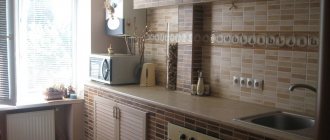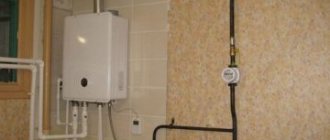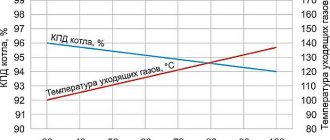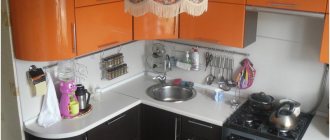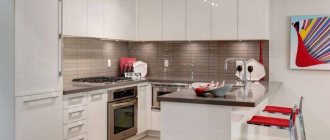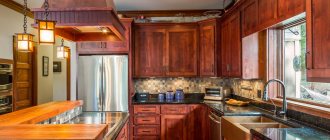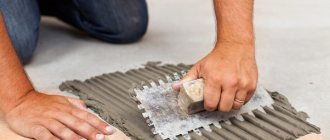To paraphrase a well-known saying of the classics, we can say that owners of small-sized kitchens in Khrushchev-era apartment buildings have two problems: a refrigerator and a gas water heater. It is difficult for a modern person to live without a refrigerator, and the gas water heater is usually located in such a way that no other kitchen cabinets fit. On the one hand, one can envy the owners of apartments with geysers: they do not have problems with interruptions in the supply of hot water. On the other hand, they own a gas appliance that requires extra space to install in a cramped kitchen. How to place everything you need comfortably and beautifully - let’s look at some design options for standard planning solutions in a Khrushchev-era kitchen.
Why is the gas water heater so inconveniently located?
Recently, blaming the inconvenient layout of Khrushchev-era apartment buildings and micro-kitchens in them has been considered almost good manners. We will not discuss the subtleties of the internal policy of the Soviet state in the field of resolving the housing issue of half a century ago. Let's consider the question of why builders place a device that heats water so inconveniently for the end user. Capitalists, of course, are not very interested in where a particular kitchen owner will have a shelf with dishes. However, gas appliances and communications to them are installed for a reason, but in accordance with the requirements for gas distribution systems and fire safety rules. General requirements and standards relating to gas pipelines and gas distribution devices are collected in SNiP 2.04.08-87 and SNiP42-01-2002.
The speaker in the kitchen must be placed in accordance with safety regulations
Briefly, for the owner of a kitchen equipped with a gas stove and gas water heater, the standards boil down to the following points:
- the distance from the gas pipeline to any building structures must allow for the possibility of dismantling and installing equipment - this means that the gas pipe must pass at a distance of at least 70 mm from the wall;
- Shut-off valves must be installed on the gas pipeline to ensure gas shutoff if necessary, and metering devices;
- the shut-off valve is installed at a height of 1500 mm from the floor and at least 200 mm to the left or right of the stove;
- gas pipeline pipes must be steel, with welded joints, the use of a flexible line is allowed only after the shut-off valve for connecting to devices, the length of the flexible line should not exceed 3000 mm;
Important! To connect gas appliances, it is permissible to use only a special flexible gas connection; flexible plumbing connections are not suitable.
- pipes supplying gas are prohibited from being walled up in walls: connection points, shut-off valves and the meter must be accessible;
- the geyser must be installed so that its lower part is at least 1200 mm from the floor, and the top of the device is no closer than 300 mm to the ceiling;
- the distance from the side surface of the gas water heater to the wall should allow for the possibility of removing and installing a new device;
The speaker should not touch the surface of the furniture
- if cabinets are hung next to the geyser, the distance between the wall of the device and the sides of the cabinets must be at least 30 mm, this requirement also applies to the case of decorating the geyser in a cabinet - the dimensions of the cabinet must take into account the dimensions of the device plus 30 mm on the sides and between the front panel and a door.
All work related to the transfer of gas supply pipes and the installation of gas distribution equipment must be carried out with an agreed project and by professional gas equipment installers. Therefore, if you are planning to move a gas burner or change the gas pipeline layout, you should first of all contact the management company, that is, the housing office.
Ventilation in Khrushchev in the bathroom and toilet
The main exhaust duct is located in the kitchen, and the one serving the bathroom and toilet is considered additional, since the total volume of air passing through it is small. Having found out the cause of poor traction, you need to analyze the operation of the entire system. What is especially important here is the presence of a full inflow, which cannot be “interrupted” by an electric kitchen hood. If this is the main reason, then it is necessary to install window or wall supply fans. These devices will restore the flow of fresh air. Their installation does not require special knowledge, but if desired, you can use the services of specialists.
Main channel and satellites
Also, an exhaust fan is installed in the ventilation hole located in the bathroom or toilet. Thanks to it, moisture and unpleasant odors will not stagnate in sanitary rooms, and the kitchen hood will not be able to draw air from the additional ventilation hole.
Important! When installing such a fan, remember that the door to the sanitary room must be slightly open during its operation. In addition, it is recommended to install not only a fan, but also a ventilation grille, through which air will escape even when the device is not working.
Can't be moved, hidden
One of the frequently proposed ways to solve the problem of a small kitchen and place all the necessary furniture and equipment in it is to make drastic changes - combining the kitchen and living room. But if you are a law-abiding citizen, then you cannot do a redevelopment that combines the kitchen and living room. More precisely, it is possible, but only if the stove in the kitchen is electric and the water heater is too. Gas equipment - a stove or gas burner is required to be installed in a room separated from living rooms by a wall with a door.
Just like in a fairy tale, the placement of the comma in this phrase is of great importance. If you decide that the amount of work, approvals and financial costs is not worth modern kitchen interior design, then we will try to solve the problem using decorative methods.
Speaker in the kitchen cabinet
- Geyser as part of a kitchen set . This is the simplest and most obvious way: enclose the gas water heater in a furniture cabinet, then from the outside it will not be noticeable where the device is located - it will be hidden by the cabinet door. When ordering furniture, you should only take into account the requirements for the installation of gas appliances.
Advice. It may be worth changing the model of the geyser if the device in your apartment is still an old model: modern models are more compact and their body is better suited for such camouflage.
- Geyser in a decorative casing. From the advice given above, another solution follows: modern models of gas instantaneous water heaters can have not only a functional, but a beautiful body that you do not want to hide. There are very decorative solutions: with a glass panel decorated with painting or photo printing.
- Geyser and refrigerator . It’s worth talking about a refrigerator in a small kitchen, but now let’s mention the option of a tandem refrigerator and geyser. If the location of the column allows, you can place a small refrigerator under the column. This option also requires the use of modern models of gas water heaters. Their design is such that the burner is located in the upper part and the bottom of the device does not heat up. In addition, they have automatic ignition: the burner flame lights up when the water is turned on, so there is no need to provide easy access to turn on the burner. When placing appliances in this way, you should take into account where the stove is located so as not to damage the refrigerator.
- If you can’t hide it, you need to show it beautifully . In an industrial or loft style interior, a gas water heater, pipes and chimney can become part of the design. Another option is suitable for a country style interior. Hang wooden shelves in a retro style on the sides of the gas water heater, place beautiful dishes or kitchen utensils on them, and draw a shelf with objects on the body of the water heater.
There are many options for hiding a gas water heater in a small kitchen. In the photo you can see various solutions.
Air exchange problems in Khrushchev
Be that as it may, the life expectancy of such houses has been increased to 100-150 years and people living in them have to put up with this state of affairs and try to correct the initial flaws in construction, which only get worse over the years. What could be the reasons for the incorrect operation of the ventilation system in Khrushchev-era buildings?
Yes, it’s beautiful, but the column is clearly too “hardwired” + plastic windows - something to think about
First, you need to note the principle of operation of natural ventilation, which was originally laid down. It consists of the influx of fresh air from windows and doors (staircases) and the removal of exhaust air through ventilation openings in the bathroom and kitchen.
Important! Natural air exchange is possible in the cold season, when the temperature difference between indoors and outdoors is noticeable. The rest of the time it can be classified as sluggish or absent.
- The first reason for disruption of normal ventilation is modern metal-plastic windows and doors with seals. Residents of Khrushchev houses built from panels quite seriously feel how “cold” this building material is. That is why they are replacing them with modern and airtight windows and doors that do not create drafts in the apartments. However, such structures do not allow fresh air into the room. As a result, a toilet smell appears, a kitchen stench blows from the exhaust duct in the bathroom and spreads throughout the apartment.
- Residents of the first, second and third floors of a five-story building do not have problems with the smell from the ventilation pipe - it safely passes by them. But residents of the upper tiers almost constantly experience such inconveniences.
- The layout of apartments in Khrushchev-era buildings does not differ in design solutions. Combined rooms, one of which is a walk-through room, kitchen 5.5 sq. m. m - they simply forced their owners to engage in independent redevelopment. The rooms had separate entrances, the kitchen was enlarged at the expense of the bathroom, and the ventilation hole was closed because it was in the way. All this “slowed down” or completely interrupted air exchange.
- The ventilation duct, made of reinforced concrete structures, has a rough surface that has collected fat deposits, soot, and dust for many years. The channel became “overgrown” and gradually narrowed, allowing less and less exhaust air to pass through, but it was never cleaned.
- The ventilation system in Khrushchev-era apartments in the kitchen, when using modern kitchen hoods and the absence of fresh air, creates low pressure in the room. To fill the empty space with air, the kitchen is filled with air masses from other rooms. If this is not enough, then it starts blowing from the hood in the bathroom.
A few words about the refrigerator
The second Achilles heel of small kitchens in Khrushchev-era apartments is the placement of the refrigerator. It is difficult to hide a large unit; as a rule, there is no room left for this device, and it goes into the corridor, into the place of a former storage room, or even into the room. But the refrigerator can hardly be called a living room decoration.
A compact refrigerator model will fit perfectly in a small kitchen.
Perhaps as part of your kitchen remodel, you might want to think about whether you really need a huge two-compartment household refrigerator? There is no shortage of food in stores, is it worth stocking up on frozen meat for six months in advance, or is it better to buy chilled meat as needed?
In addition to refrigerators with freezers, there are appliances on sale that only have a cooling chamber. They are much more compact - there is no need for a thick layer of thermal insulation and a large compressor. Such models are often designed for installation under a countertop.
There are also options for independent appliances: the freezer and refrigerator compartments are designed as independent separate appliances that can be more conveniently placed in the kitchen. Or even leave only the refrigerator in the kitchen area, because it is used more often. And put the freezer in another room.
If you approach the interior design of a small-sized kitchen thoughtfully, then a small area is not a death sentence. There is always an optimal solution for creating a comfortable living space.
Ventilation diagram in Khrushchev
Transition of the ventilation duct from the bathroom to the kitchen
The ventilation system in such houses is provided for natural air exchange. So, through natural cracks in wooden windows and loose doors, air came from outside. Moving through all the rooms, it rushed into the exhaust duct, equipped in the kitchen and an additional one in the bathroom.
In the sanitary rooms, bathroom and toilet, if they were separate, one ventilation duct was installed (above the bathroom). Between these rooms there was a window, which was generally kept open, except for the time when someone was “basking” in the bathroom. Thanks to this small window, all the odors rose up and went into the ventilation hole.
Exhaust air from each apartment entered a ventilation shaft with an exit above the roof. In the 70s, additions were made to the planning of Khrushchev houses and some houses began to be built with an additional ventilation duct for toilets.
Another ventilation project implemented in those years was satellite channels. They are ready-made reinforced concrete blocks made in a factory, which were delivered to construction sites in finished form. The principle of their operation was to connect a number of satellite channels to a common shaft. With connection diagram - through the floor. So, the first floor was connected to the channel, the second - to the first, after 2.5 meters the third - to the shaft, the fourth - to the third.
By the way. It was planned that the air from the apartment, discharged into the satellite channel, would not come into contact with the air from other apartments, since they would be closed with plugs. But either they were in a hurry to build, or they saved on something, but in houses with such ventilation, the neighbors above always know the lunch menu of the neighbors below.
In addition, ventilation was installed in the floor in the Khrushchev building. Such air exchange was needed exclusively in houses where wooden floors were laid. The floorboards were installed on wooden joists, and a ventilation grill was installed in the corner of each room. The air coming from the windows and doors not only passed through the room, but also fell under the floor, expelling stagnant air and moisture from there. Thus, the tree did not rot for a long time. Many residents of Khrushchev houses, where floor ventilation was installed, did not understand its purpose and closed the ventilation hole, which they later regretted when they had to change the floors.
How to place a refrigerator and gas heater in the kitchen: photo
How to hide pipes?
Don’t forget that there are communications running towards the column that will also need to be hidden. Be sure to check out our article “5 Ways to Hide a Gas Pipe.”
Briefly:
- paint the pipes, it’s effective and inexpensive;
- disguise the pipe as a roof rail;
- use hanging furniture to hide communications;
- make a box and run pipes there;
- as a last resort, move the pipes with the help of a gas service.
Placement between wall cabinets
There are situations when it is not possible to build a speaker into a set, but it can be hidden between wall cabinets. This arrangement option is practical and does not require costs.
It must be remembered that in this case there are certain requirements:
- the distance between the side walls of the column and wall cabinets must be at least 3 cm;
- the walls of adjacent cabinets must be insulated with non-combustible material.
Important! The color of the speaker should match the set or, conversely, be a bright accent in the interior.
Average prices per set
The average cost of the kit primarily depends on the length of the chimney and the diameter of the selected pipe.
When purchasing, please note that aluminum corrugation stretches from the original length of 0.65cm to 3m. Stainless steel products have little stretch. Average cost of products:
- Aluminum - 200 rub/m;
- Stainless steel sleeve – 650 rub/m.
In addition, you should purchase special metal tape, sealants and the necessary fittings.
The average cost of a complete set made of aluminum is 500 rubles, from stainless steel - 1000 rubles.
We use PVC panels
The properties of plastic panels allow them to be easily used as finishing materials for premises:
- Environmentally friendly - there are no toxic fumes.
- Durable and reliable - can be used without deformation for many years.
- The widest selection of colors and textures.
The most important thing when choosing PVC panels is to match them to the interior of the kitchen. In most cases, this is quite problematic, since it is rare that kitchen walls are covered with panels.
Disadvantages include the impossibility of permanent access to the column, which may entail a fine from inspection services.
We disguise it as a general interior
One of the easiest ways to “bring” a gas water heater into the kitchen interior is to cover it with the same wallpaper as the walls of the room. Or cover it with a vinyl film similar to them in style and color. You can also match the shade of the film for the water heater to the kitchen unit.
The best option is to paint the speaker with non-flammable paint to match the walls or furniture. Heat-resistant enamel, which is intended for coating metal, is best suited for these purposes.
However, you can use a regular spray can, then even a teenager can cope with the task. In this case, do not forget to cover the screen and handles of the device with masking tape, and also cover the surface behind the speaker.
Make sure that the blinds do not touch the column and have an indentation of several centimeters.
Main location options
Due to the small number of Khrushchev kitchens, the number of options for the location of the column is strictly limited and depends primarily on the type of layout you choose.
With a linear layout
The kitchen set is located along one wall. The column is mounted above the sink (not recommended, but acceptable for small rooms of 4-6 square meters) or above the work surface. With this ergonomics, the proximity of the heater to the stove and refrigerator is excluded: the first is placed closer to the window, and the second is often placed on the opposite wall, right next to the dining area.
With a corner layout
The set is already located along two adjacent walls, forming an easily readable letter “G”. This ergonomics is considered more convenient, since the rule of the working triangle (cooking, storage and washing areas) has not been canceled. The column is placed in the corner and in the vast majority of cases is hidden behind cabinets.
Varieties
There are several types of household gas appliances.
- A gas stove is a device that is designed for cooking food directly on the stove. Appliances include from one to four burners. The stoves are available with or without an oven.
- Geyser - designed for heating water in a residential area. The dispensers are automatic (they light up on their own and maintain the set water temperature), semi-automatic (require adjustment depending on the water pressure, etc.), manual (each time you need to manually start the dispenser and monitor its operation).
- Gas boiler - designed to work in a room heating system if the boiler is single-circuit, and for heating and heating running water - if it is double-circuit.
- Gas burners for heating stoves - the name itself speaks about its purpose, that is, for heating a room using brick stoves.
- Gas metering devices are designed to record the amount of fuel pumped through them. For the consumer, this means the amount of substance used.
Summary
Having chosen a hood by carefully selecting it to match the color and design of the kitchen unit, you are faced with a choice: turn to professionals for help in installation, paying a substantial fee for installing a kitchen hood; or hang it yourself, after reading our article.
The most important thing when installing a kitchen hood is: objectively assess your strengths and the possibility of receiving help from household members; evaluate the instrumentation before starting work; understand the instructions included with the hood and believe in yourself.
